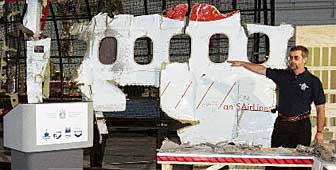
Swissair crash probe calls for better firefighting methods

The Canadian agency investigating the crash of Swissair Flight 111 has called for airlines and industry regulators to do a better job of training and equipping crews to detect and fight fires aboard planes.
As part of its probe into the 1998 crash off the coast of Nova Scotia, the Canadian Transportation Safety Board issued five recommendations on Monday aimed at helping to reduce risks identified with the Swissair accident.
In Zurich, Swissair stressed that “the implementation of these recommendations has already begun” and said it was pushing forward safety efforts “without consideration of costs.”
The jet, headed for Geneva from New York, went down off Canada’s Atlantic coast after pilots reported smoke in the cockpit and changed course to attempt an emergency landing in Halifax, Nova Scotia.
It is still not clear what caused the fire on board the aircraft. The Canadian authorities are due to release in April or May their final report on the crash, which cost the lives of 229 people on September 2, 1998.
Investigators in the Canadian town of Shearwater said they’d found evidence of heat damage consistent with a fire in the ceiling near the bulkhead separating the cockpit flight deck from the passenger cabin.
The safety board said it wants industry standards to “reflect a philosophy that when odour/smoke from an unknown source appears in the aircraft, the most appropriate course of action is to prepare to land the aircraft expeditiously.”
In the moments leading up to Flight 111’s crash, the pilots diverted away from Halifax airport to begin dumping fuel ahead of landing, a decision that cost precious minutes as fire apparently raged in the jet.
Swissair responded to the recommendations in a statement on Monday evening saying that last year it had changed its philosophy regarding cockpit procedure in case of smoke.
The airline said that it “now calls on pilots to land as soon as possible if smoke from an unknown source is detected.”
Furthermore, the Swiss carrier said modifications had been included in new training guidelines, and it highlighted the fact that “additional fire detection and suppression systems will be developed together with the manufacturer and submitted for regulatory approval.”
The board also wants a review of in-flight firefighting procedures, including training, equipment and accessibility to spaces such as aircraft attic areas.
It further recommended that the emergency checklist used by flight crews to assess odour and smoke be better designed to rapidly eliminate the heat source before a fire breaks out.
“Response time is critical in a fire situation,” crash investigator Vic Gerden said.
Officials said that regulatory authorities and the aviation community should review the adequacy of in-flight firefighting.
The board said it wanted a review of the methodology for establishing designated fire zones in the pressurised portion of an aircraft.
Along with the recommendations, the safety board announced it was completing the reconstruction phase of the probe, in which two million pieces were collected to partially rebuild the MD-11.
swissinfo with agencies

In compliance with the JTI standards
More: SWI swissinfo.ch certified by the Journalism Trust Initiative




























You can find an overview of ongoing debates with our journalists here . Please join us!
If you want to start a conversation about a topic raised in this article or want to report factual errors, email us at english@swissinfo.ch.